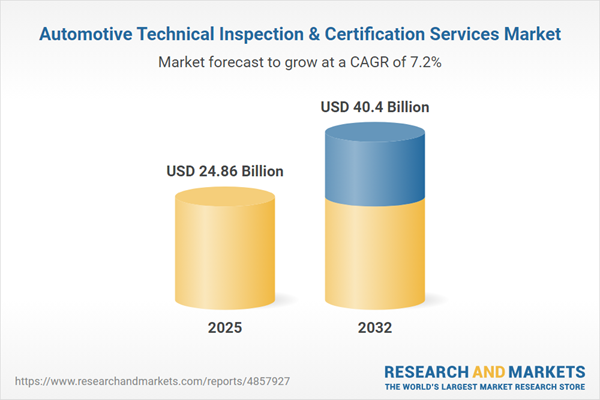Speak directly to the analyst to clarify any post sales queries you may have.
The automotive technical inspection and certification services market is undergoing rapid transformation, driven by digital innovation and the growing complexity of regulatory environments. Senior executives face heightened pressure to modernize compliance processes, optimize operational resilience, and make informed strategic investments in this evolving sector.
Market Snapshot: Automotive Technical Inspection and Certification Services Market
The global automotive technical inspection and certification services market is positioned for significant growth, projected to increase from USD 23.22 billion in 2024 to USD 24.86 billion in 2025, with a compound annual growth rate (CAGR) of 7.16%. By 2032, the market is expected to reach USD 40.40 billion. Key market drivers include stricter emissions and safety regulations, increasing implementation of digital inspection technologies, and a stronger focus on data-driven compliance management. As the industry adapts to new electronic vehicle technologies and aligns with global inspection frameworks, organizations are reshaping vehicle system standards and embedding digital transformation as a core aspect of compliance and certification strategy.
Scope & Segmentation: Strategic Focus Areas
This report offers a comprehensive view for executives, highlighting critical market segments, technology trends, and global dynamics essential for strategic planning within automotive technical inspection and certification services.
- Service Type: Includes emissions and safety certification, technical advisory, general inspections, and specialized component evaluations, all supporting compliance throughout the automotive product lifecycle.
- Vehicle Type: Details compliance pathways for commercial heavy-duty vehicles, light-duty vehicles, passenger vehicles, and specific models such as hatchbacks, sedans, and SUVs, emphasizing distinct regulatory needs in each category.
- Application: Encompasses emission diagnostics, engine and fuel system inspections, and safety verifications, ensuring organizations sustain quality standards and proactively mitigate operational risks.
- End User: Covers automotive manufacturers, aftermarket service providers, independent labs, and regulatory authorities, each holding responsibility for industry-wide enforcement and certification integrity.
- Inspection Mode: Addresses both onsite and digital remote inspection models, providing organizations agility to comply with continually evolving regulatory landscapes and embrace new technology integrations.
- Regional Coverage: Analyzes trends across the Americas, Europe, Middle East and Africa, and Asia-Pacific, with special focus on markets like China, India, Japan, Australia, South Korea, and Southeast Asia, supporting tailored regional risk and opportunity management approaches.
- Companies Covered: Presents benchmarking and competitive insights for leading firms including DEKRA SE, TÜV SÜD AG, TÜV Rheinland AG, SGS SA, Bureau Veritas SA, Applus Services S.A., Intertek Group plc, UL LLC, Eurofins Scientific SE, and Kiwa N.V., all shaping sector practices through standard-setting and collaborative initiatives.
Key Takeaways for Senior Decision-Makers
- Adopting AI-supported digital inspection and cloud-enabled remote audit solutions can help organizations achieve greater operational flexibility and faster responses to regulatory updates.
- Rising electrification and automation demand new approaches to inspection protocols and workforce skills, ensuring compliance with increasingly complex vehicle architectures.
- Leveraging advanced analytics enables early identification of regulatory developments and supports proactive risk mitigation, safeguarding long-term market positioning.
- Combining digital and in-person inspection strategies provides vital adaptability for addressing diverse regional regulations and fulfilling specific client requirements.
- Strategic alliances, particularly in battery systems and autonomous vehicle assessments, give access to unique technical expertise and bolster innovation capacity in inspection services.
- Localized testing infrastructure supports business continuity and market responsiveness, especially within regions experiencing shifting or expanding regulatory activity.
Tariff Impact: Operational Shifts in the United States for 2025
Anticipated adjustments to U.S. tariff policies are driving organizations to increase domestic investment in inspection technology and strengthen regional testing operations. These efforts, including new alliances with original equipment manufacturers, aim to enhance supply chain reliability, maintain regulatory preparedness, and promote strategic adaptability amidst ongoing changes in the U.S. regulatory landscape.
Methodology & Data Sources
Findings are based on direct interviews with senior market leaders and insights from key industry stakeholders, ensuring perspectives reflect real-world operational priorities. Review of the most relevant regulatory frameworks and primary sources provides depth, aligning research outcomes with senior executive decision-making needs.
Why This Report Matters
- Enables detailed segmentation and competitor benchmarking, equipping executives to spot growth opportunities and guide investments in automotive technical inspection and certification services.
- Assists leaders in navigating turbulent regulatory conditions, supporting business continuity, and minimizing compliance risk exposure across markets.
- Delivers clear recommendations for advancing digital transformation and infrastructure to meet evolving compliance and operational requirements within automotive organizations.
Conclusion
This report provides actionable market intelligence, empowering senior decision-makers to address compliance complexity, enhance operational robustness, and drive strategic growth within automotive technical inspection and certification services.
Additional Product Information:
- Purchase of this report includes 1 year online access with quarterly updates.
- This report can be updated on request. Please contact our Customer Experience team using the Ask a Question widget on our website.
Table of Contents
3. Executive Summary
4. Market Overview
7. Cumulative Impact of Artificial Intelligence 2025
Companies Mentioned
The companies profiled in this Automotive Technical Inspection & Certification Services market report include:- DEKRA SE
- TÜV SÜD AG
- TÜV Rheinland AG
- SGS SA
- Bureau Veritas SA
- Applus Services, S.A.
- Intertek Group PLC
- UL LLC
- Eurofins Scientific SE
- Kiwa N.V.
Table Information
| Report Attribute | Details |
|---|---|
| No. of Pages | 193 |
| Published | November 2025 |
| Forecast Period | 2025 - 2032 |
| Estimated Market Value ( USD | $ 24.86 Billion |
| Forecasted Market Value ( USD | $ 40.4 Billion |
| Compound Annual Growth Rate | 7.1% |
| Regions Covered | Global |
| No. of Companies Mentioned | 10 |









